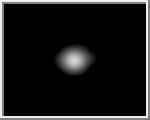













|
Adrastea [a-DRAS-tee-uh] is the second innermost known satellite of Jupiter. Adrastea was the daughter of Jupiter and Ananke and the distributor of rewards and punishments. Adrastea and Metis lie within Jupiter's main ring and may be the source of material for the ring. Very little is known about Adrastea.
| Views of Adrastea |
|---|
 Galileo Image of Adrastea
Galileo Image of Adrastea
This image of Adrastea was taken by Galileo's solid state imaging system between
November 1996 and June 1997. Although Adrastea was discovered by Voyager, it was
no more than a point of light on images.
Adrastea orbits Jupiter in the zone between the planet's ring and the larger
Galilean satellites. The longest dimension of Adrastea is approximately 20
kilometers (12 miles) across.
(Courtesy of NASA/Cornell University)
 Discovery Image
Discovery Image
This is the discovery image (FDS 20630.53) of Adrastea. It was taken by
the Voyager spacecraft 23 hours before the closest approach to Jupiter.
This image is a wide angle picture taken with a 15 second exposure.
The range is 1.4 x 106 km. The faint line is the Jovian ring. Adrastea
is a small dot above the arrow. The brighter dot to the left is a star.
(Copyright Calvin J. Hamilton)
 Subsequent Observation
Subsequent Observation
This image (FDS 20630.48) of Adrastea was taken 5 minutes earlier than
the previous image. The exposure time was 96 seconds. The faint band
is the Jovian ring and is smeared because of parallax and spacecraft
motion. Adrastea is the bright line in the lower right. A star can
be seen as a line in the upper left. Notice the difference in length
and direction of the two lines. This image was used to verify that
the spot in the previous image was indeed a satellite of Jupiter.
(Copyright Calvin J. Hamilton)
![]() Family Portrait of the Small Inner Satellites of Jupiter
Family Portrait of the Small Inner Satellites of Jupiter
These images, taken by Galileo's solid state imaging system between
November 1996 and June 1997, provide the first ever "family portrait"
of the four small, irregularly shaped moons that orbit Jupiter
in the zone between the planet's ring and the larger Galilean satellites.
The moons are shown in their correct relative sizes, with north approximately
up in all cases. From left to right, arranged in order of increasing distance
from Jupiter, are Metis (longest dimension is approximately 60 kilometers or
37 miles across), Adrastea (20 kilometers or 12 miles across), Amalthea
(247 kilometers or 154 miles across), and Thebe (116 kilometers or 72 miles
across). While Amalthea, the largest of these four tiny moons, was imaged
by NASA's two Voyager spacecraft in 1979 with a resolution comparable to what
is shown here, the new Galileo observations represent the first time that
Metis, Adrastea, and Thebe have been seen as more than points of light.
(Courtesy of NASA/Cornell University)
| References |
|---|
Jewitt, David C. et al. "Discovery of a New Jupiter Satellite." Science, Vol 206, 23 November 1979.
Synnott, S. P. "Orbits of the Small Inner Satellites of Jupiter." Icarus 58, 1984.
Copyright © 1997-2000 by Calvin J. Hamilton. All rights reserved. Privacy Statement.